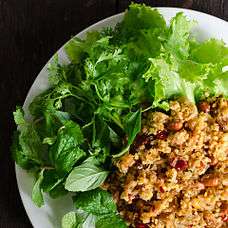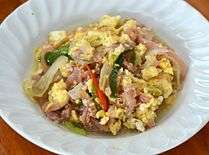Naem
  Naem khluk ("mixed naem") is a Thai salad prepared with naem. At bottom is a close-up view of the same dish | |||||||
| Type | Fermented sausage | ||||||
|---|---|---|---|---|---|---|---|
| Place of origin | Thailand | ||||||
| Serving temperature | Raw or cooked | ||||||
| Main ingredients | Pork | ||||||
| Ingredients generally used | Minced beef is sometimes used | ||||||
| 185 kcal (775 kJ) | |||||||
| |||||||
|
| |||||||
Naem (Thai: แหนม, pronounced [nɛ̌ːm], also referred to as nham, naem moo, naem maw, and chin som)[1][2] is a pork sausage in Thai cuisine. It is a fermented food that has a sour flavor. It typically has a short shelf life, and is often eaten in raw form after the fermentation process has occurred. It is a popular food in Thai cuisine, and different regions of Thailand have various preferred flavors, including variations of sour and spicy. Naem is used as an ingredient in various dishes and is also served as a side dish.
Naem contains 185 kilocalories per a serving size of 100 grams (3.5 oz) and contains a significant amount of protein, has a moderate amount of fat and minor carbohydrate content. Parasites and enteropathogenic bacteria have been found in samples of naem, and lactic acid formed during its fermentation inhibits the growth of Salmonella. Lactobacillus curvatus use in the product has been proven to prevent the growth of pathogenic bacteria in naem. It is sometimes treated with irradiation. The bacterial content in Thai sour pork products is regulated.
Overview
Naem is a red-colored, semi-dry lactic-fermented pork sausage in Thai cuisine prepared using minced raw pork and pork skin, significant amounts of cooked sticky rice, chili peppers, garlic, sugar, salt and potassium nitrate.[3][4][5][6] Minced beef is sometimes used in its preparation.[5] After the mix is prepared, it is encased in banana leaves, synthetic sausage casings or tubular plastic bags and left to ferment for three to five days.[3][4] Naem has a sour quality to it due to the fermentation, in which lactic acid bacteria and yeasts grow within the sausage.[4] The lactic acid bacteria and yeasts expand by feeding upon the rice and sugar, and the use of salt prevents the meat from rotting.[4]
Naem typically has a short shelf life, which can be extended through refrigeration.[3] The sausage can be time-consuming and labor-intensive to prepare.[3] In Thailand, it is typically stored at room temperature, which gives it a shelf life of around one week.[3] It is also produced in areas of Southeast Asia that are near Thailand.[7]
Naem is often consumed raw,[8] (after fermentation has occurred), and is often accompanied with shallot, ginger, bird’s eye chili peppers and spring onions.[4] It is used as an ingredient in various dishes[9] such as naem fried with eggs, Naem khao and Naem phat wun sen sai khai, and is also consumed as a side dish and as a condiment.[10] The cooking of naem significantly changes its flavor.[8]
Prominence
Naem has been described as "one of the popular meat products of the country prepared from ground pork"[5] and as "one of the most popular traditional Thai fermented meat products".[6]
Varieties
Naem mo in northern Thailand may be fermented in a clay pot.[11] Different regions of Thailand have different preferred flavors: northern and northeastern pork is a little bit sour, central is sour and southern is spicy.
Use in dishes
Dishes prepared with naem include naem fried with eggs, and naem fried rice.[4] Naem phat wun sen sai khai is a dish prepared with naem, glass noodles and eggs, among other ingredients such as spring onions and red pepper.[12] Naem khao is a salad dish in Lao cuisine prepared using Lao fermented pork sausage, rice, coconut, peanuts, mint, cilantro, fish sauce and lemon juice.[13] The naem and rice are formed into balls, deep-fried, and then served broken atop the various ingredients.[14] A restaurant named "Serenade" in Bangkok, Thailand purveys a dish called the "McNaem", which consists of a duck egg wrapped in naem that is fried and then plated atop a dish with risotto, slaw, shiitake mushrooms, herbs and cooked sea scallops atop crushed garlic.[15]
There are many applications of sour pork with different flavors such as phat phet naem (Thai: ผัดเผ็ดแหนม), tom kha naem (Thai: ต้มข่าแหนม), ho mok naem (Thai: ห่อหมกแหนม), and naem priao wan (Thai: แหนมเปรี้ยวหวาน).[16]
- Dishes prepared with naem
- Chin som mok – a speciality of northern Thailand, it is the northern Thai version of naem sausage
- Khua chin som sai khai – a dish prepared with dry-fried pickled pork and egg. Chin som is the northern Thai name for naem
- Yam naem – a Thai salad prepared with naem and other ingredients
 Phat naem sai khai – naem stir fried with egg
Phat naem sai khai – naem stir fried with egg
Nutritional content
| Nutritional value per 100g | |
|---|---|
| Energy | 774.04[17] kJ (185.00 kcal) |
|
3.6 [17] | |
|
9.9 g [17] | |
|
20.2 g [17] | |
| |
| Percentages are roughly approximated using US recommendations for adults. | |
Per a serving size of 100 grams (3.5 oz), Naem has 185 kilocalories, 20.2 grams (0.71 oz) protein, 9.9 grams (0.35 oz) fat and 3.6 grams (0.13 oz) carbohydrate.[17] Per the work "Industrialization of Thai Nham" by Warawut Krusong of the King Mongkut's Institute of Technology Ladkrabang in Bangkok, Thailand, vitamins B1 and B2, ferric iron and phosphorus were present in naem, but the quantities were unspecified.[17]
Microbiology
Naem has on occasion been contaminated with parasites such as Taenia solium and Trichinella spiralis and enteropathogenic bacteria such as coliform bacteria and Salmonella.[6] It has been demonstrated that Salmonella growth is inhibited by the formation of lactic acid during the fermentation process.[6] Use of the starter culture Lactobacillus curvatus has been demonstrated to prevent "the outgrowth of pathogenic bacteria" in naem.[5] Naem is sometimes treated with irradiation.[8]
Regulations on bacterial content
The bacterial content in Thai sour pork products is regulated. There should not be more than 0.1 grams (0.0035 oz) of Escherichia coli O157:H7, Staphylococcus aureus not more than 0.1 grams (0.0035 oz), Yersinia enterocolitica not more than 0.1 grams (0.0035 oz), Listeria monocytogenes not more than 0.1 grams (0.0035 oz), Clostridium perfringens not more than 0.1 grams (0.0035 oz), Fungi less than 10colony per gram, Trichinellaspiralis less than 100 grams (3.5 oz).[16] If any of these bacteria exist at higher levels than described above it may cause sickness.[16]
See also
- List of fermented foods
- List of sausages
- Sai krok Isan – a fermented sausage originating in the Northeastern provence of Thailand
- Sai ua – a grilled pork sausage from northern Thailand and northeastern Burma
- Nem chua
References
- ↑ Doughty, K.; Lewis, L.; Books, M. (2009). Food of Asia. Murdoch Books. p. 13. ISBN 978-1-74196-419-6.
- ↑ http://library.cmu.ac.th/ntic/en_lannafood/detail_lannafood.php?id_food=144
- 1 2 3 4 5 Applications of Biotechnology to Traditional Fermented Foods: Report of an Ad Hoc Panel of the Board on Science and Technology for International Development. National Academies Press. 1992. pp. 121–130. ISBN 978-0-309-04685-5.
- 1 2 3 4 5 6 "Thai Food Master". Making Fermented Thai Pork Sausage. February 24, 2010. Retrieved 8 April 2015.
- 1 2 3 4 Hui, Y.H.; Evranuz, E.Ö. (2012). Handbook of Animal-Based Fermented Food and Beverage Technology, Second Edition. Handbook of fermented food and beverage technology. CRC Press. p. 67. ISBN 978-1-4398-5023-7.
- 1 2 3 4 Steinkraus 2004, pp. 721-736.
- ↑ Toldrá, Fidel (2014). Handbook of Fermented Meat and Poultry. John Wiley & Sons. pp. 939–940. ISBN 1118522672.
- 1 2 3 Satin, Morton (1996). Food Irradiation: A Guidebook, Second Edition. CRC Press. p. 131. ISBN 1566763444.
- ↑ Ling, K.; Tsai, M.; Liew, C.; Tettoni, L. (2012). The Asian Kitchen. Tuttle Publishing. p. 385. ISBN 978-1-4629-0532-4.
- ↑ Batt, C.A.; Robinson, R.K. (1999). Encyclopedia of Food Microbiology. Elsevier Science. p. 850. ISBN 978-0-12-384733-1.
- ↑ Evans, B. (2008). Thai Phrasebook 6th Edition. Lonely Planet phrasebooks. Lonely Planet. p. 180. ISBN 978-1-74059-734-0.
- ↑ "Cured Pork Fried with Glass Noodles and Egg". Thai Food Master. February 23, 2010.
- ↑ Publishing, DK (2011). Ultimate Food Journeys: The World's Best Dishes and Where to Eat Them. DK Publishing. p. 237. ISBN 978-0-7566-9588-0.
- ↑ Bush, A.; Elliot, M.; Ray, N. (2010). Laos. Country Guide Series. Lonely Planet. p. 61. ISBN 978-1-74179-153-2. Retrieved April 9, 2015.
- ↑ Lowe, G. (2011). Cool Bangkok: Your Essential Guide to What’s Hip and Happening. Your essential guide to what's hip & happening. Marshall Cavendish International Asia Pte Ltd. p. 46. ISBN 978-981-4435-38-3.
- 1 2 3 Praphailŏng, W. (2000). ตำรับอาหารแหนมเอกลักษณ์ไทย. 539/2 Gypsum Metropolitan Tower, Floor 21A Si Ayutthaya Road, Ratchathewi, Bangkok, 10400.BIOTEC, NSTDA, Ministry of Science and Technology Thailand.: NSTDA.
- 1 2 3 4 5 6 Steinkraus 2004, p. 722.
Bibliography
- Steinkraus, K. (2004). Industrialization of Indigenous Fermented Foods, Revised and Expanded. Food Science and Technology. Taylor & Francis. pp. 721–736. ISBN 978-0-8247-5094-7.
Further reading
| Wikimedia Commons has media related to Naem. |
- Acton, Q.A. (2013). Lactobacillus—Advances in Research and Application: 2013 Edition. Scholarly Editions. p. 90. ISBN 978-1-4816-8929-8.
